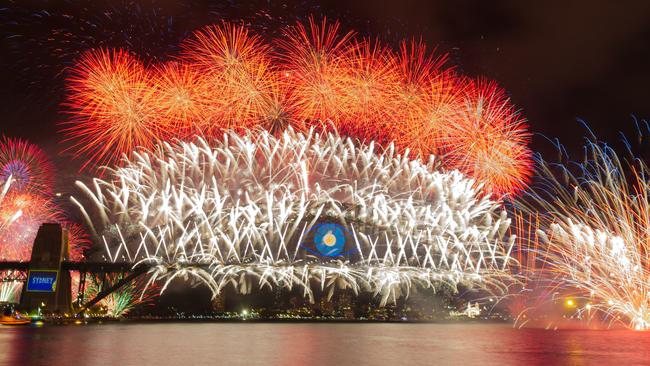New Year celebrations can last for months
For one billion people around the world, televised images of Sydney’s festive $7 million bonfire exploding over the harbour will herald the start of a new year.

Today in History
Don't miss out on the headlines from Today in History. Followed categories will be added to My News.
The remote coral atoll of Kiritimati, or Christmas Island, in Kiribati will be first to ring in 2015 tonight; Samoa, Tonga and New Zealand follow within an hour.
But for one billion people around the world, televised images of Sydney’s $7 million bonfire exploding over the harbour two hours later will herald the start of a new year.
Melbourne and Vladivostok celebrate with us. Festivities will move to concerts on the sand in Rio, blockbuster bonfires in Reykjavik and Hogmanay parties in the crowded streets of Edinburgh.
It was the Roman senate which decreed January 1 as the start of the consular new year in 153BC, but global adoption of a universal new year remains haphazard.
Babylonians 4000 years ago celebrated new year as winter thawed at the end of what is now March, when crops were planted for the coming year. Egyptians, Phoenicians and Persians began the year at the autumn equinox about September 21. For early Greeks, it began with the winter solstice on December 21.
Romans decided to start the consular year on January 1 during the Second Celtiberian War of 154BC in Spain. A new consul was designated for the new year, then on March 15. Moving the date two months delivered a military advantage.
Emperor Julius Caesar made January 1 the door to a new year in 46BC, when he adopted the Alexandrian calendar of 239BC, after conquering Egypt in 48BC.
The calendar consisted of a solar year of 365 days, divided into 12 months, with an extra day every fourth year. Caesar believed the month named for Janus, Roman god of doors and gates with two faces, one looking forward and one back, was an appropriate start for a new year. Drunken orgies became a ritual for Roman new year celebrations, apparently to re-enact the chaotic world that existed before gods brought order to the universe.
Early Christians condemned new year celebrations, but as the church converted pagans to Christianity, it designated January 1 as the Feast of Christ’s Circumcision.
At the Second Council of Tours in 567, Pope John III prescribed prayers and a Mass for New Year’s Day, and banned dancing. The celebration also moved from January 1 to Annunciation Day, or Lady Day, on March 25, when the Angel Gabriel appeared to tell the Virgin Mary she would give birth to Jesus in nine months.
The date was adopted across medieval Europe, although England observed New Year on Christmas Day. When William the Conqueror became king on December 25, 1066, he unsuccessfully decreed that England should return to the Roman new year date of January 1. England instead joined Europe in celebrating on March 25.
Under Pope Gregory in 1582 the Catholic Church adopted the Gregorian calendar, restoring New Year’s Day to January 1. Adopted immediately in Italy, Spain and Portugal, other European Catholic nations gradually followed. Scotland changed in 1600, Germany and Denmark in about 1700.
England, refusing to take instructions from a pope since Henry VIII’s break with Rome in the 1530s, did not change until the Calendar Act of 1750.
Although Samuel Pepys’ diary indicates January 1 was commonly used as new year in 1660, officially March 24, 1642 was followed by March 25, 1643. Under the English Calendar Act, December 31, 1751 was followed by January 1, 1752, so 1751 lasted only nine months.
The Jewish religious calendar begins the year on Rosh Hashana, the first day of the month of Tishri, between September 6 and October 5. The Muslim calendar normally has 354 days, with the new year beginning in the month of Muharram, which in 2014 coincided with October.
Chinese New Year falls in late January or early February, at the lunar beginning of spring. Tamils in southern India celebrate new year at the winter solstice, while Thailand celebrates in March or April. Japan has a three-day celebration on January 13. In the Balinese-Javanese Saka Calendar, New Year is known as Nyepi and falls on March 21, 2015. A day of silence, fasting and meditation is observed for 24 hours from 6am, when no one is allowed on beaches or streets.
The Scots tradition of Hogmanay perhaps dates to Norse celebrations of the winter solstice. As town hall bells ring in the new year, torches are set alight and swung around as revellers march the streets.
In New York, a million people fill Times Square to watch an illuminated 320kg ball descend a pole in the final seconds of the old year. New York Times publisher Adolph Ochs introduced the tradition in 1906, replacing a fireworks display he initiated in 1903 in the square named after his newspaper.
In American Samoa, 2015 will begin almost 25 hours after celebrations by their eastern neighbours, 120km away.


